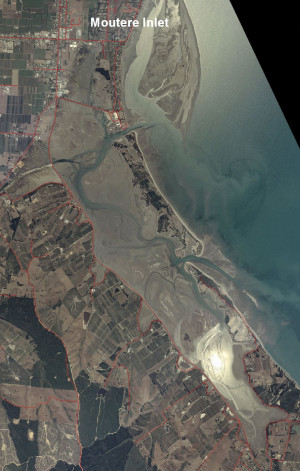 Moutere Inlet is a moderate-sized (764 ha), well-flushed, shallow, intertidally-dominated, estuary located near Motueka. The estuary consists of one main basin with a tidal opening at each end of Jacket Island, and several tidal embayments separated from the main estuary basin by roads/causeways. The estuary is shallow (mean depth ~2 m) and almost completely drains at low tide. Intertidal habitats are characterised by wide sandflats and mudflats - many perched high in the tidal range - and well flushed, steeply incised drainage channels, particularly near the entrances. These channels contain a variety of cobble, gravel, sand and biogenic (oyster, mussel, tubeworm) habitats, and support localised macroalgal growths. Although significantly reduced from their historical range, small patches of seagrass remain in the lower tidal reaches of the estuary, and salt marsh is present along the upper tidal margins.
Moutere Inlet is a moderate-sized (764 ha), well-flushed, shallow, intertidally-dominated, estuary located near Motueka. The estuary consists of one main basin with a tidal opening at each end of Jacket Island, and several tidal embayments separated from the main estuary basin by roads/causeways. The estuary is shallow (mean depth ~2 m) and almost completely drains at low tide. Intertidal habitats are characterised by wide sandflats and mudflats - many perched high in the tidal range - and well flushed, steeply incised drainage channels, particularly near the entrances. These channels contain a variety of cobble, gravel, sand and biogenic (oyster, mussel, tubeworm) habitats, and support localised macroalgal growths. Although significantly reduced from their historical range, small patches of seagrass remain in the lower tidal reaches of the estuary, and salt marsh is present along the upper tidal margins.
Overall, despite extensive historical habitat modification, much reduced habitat diversity, and large areas of mud, the estuary retains significant ecological value, although it is currently expressing moderate symptoms of eutrophication and muddiness. Without reductions in current nutrient and sediment loads the estuary is likely to remain in a similar state to its present condition, and salt marsh losses are likely to increase in response to sea level rise.
More information and monitoring data is also available on the LAWA website.(external link)
For easier viewing, use this link to open this summary in a new window.
The surrounding catchment is highly modified and dominated by pasture (53%), horticulture (15%), exotic forestry (12%) and built up areas (settlements) (2%), including the commercial port and marina located at Port Motueka. Native forest cover is low (2%).
The extent of mud-dominated substrates is the most significant current issue present in Moutere Inlet, in part as most of the sediment entering the estuary (96%) is predicted to be trapped and retained within it. Most mud is located in the central basin and to the southeast and, to a lesser degree, in the sheltered embayments on the western side of the estuary and north of Wharf Road – ideal settling areas for fine sediment. The spatial extent of mud is high in both a regional and national context although there appears to have been a recent reduction in mud extent (22 ha, 9% since 2013) and an obvious decrease in sediment volume in certain parts of the estuary, most particularly the central basin. Despite the high extent of mud-dominated substrates, analysis of sediment plate monitoring (collected by TDC) showed that net rates of measured sediment accumulation (average 0.2 mm/year over the past decade) were well below the 2 mm/year guideline value proposed for New Zealand estuaries, and comparable to the 0.9 mm/year calculated from NIWA’s national estuary sediment load estimator. However, in the central basin where deposition appears most pronounced, sediment cores analysed using forensic methods (lead and caesium radioisotopes) estimated mean sediment accrual is high at ~10 mm/year from 1988 to 2018.
In Moutere Inlet, the extent of High Enrichment Conditions (HEC) has expanded significantly over time, from an estimated ~1 ha (0.1% of estuary area) in 1947, to 37 ha (5%) in 2004 and to 60 ha (8%) in 2013, before decreasing to 31 ha (4.1%) in 2019. The large decrease in both macroalgal cover (48 ha) and HEC extent (29 ha) since 2013 is very positive, although the specific reasons for the changes are unclear.
Small seagrass (Zostera) beds were present (3.1 ha) primarily in the central basin near the Kina entrance, with an apparent increase of 1.1 ha since 2013 and 2.2 ha since the first reliable baseline in 2004.
Salt marsh vegetation is a prominent feature (83 ha, 10.8% of the estuary), with no appreciable change from 2004 or 2013. Salt marsh was dominated by rushland (55%) and herbfield (40%) and was most common within estuary embayments and on the northwest and southern tidal flats. Compared to historical extent, there has been an estimated reduction of ~45% since 1947, most losses due to reclamation and drainage.
The 200 m wide terrestrial margin bordering the estuary was also highly modified and dominated by residential/industrial development (21.7%), pasture (28.6%) and horticulture (19.5%). Only 16% was densely vegetated, half of which was exotic.
Last modified: